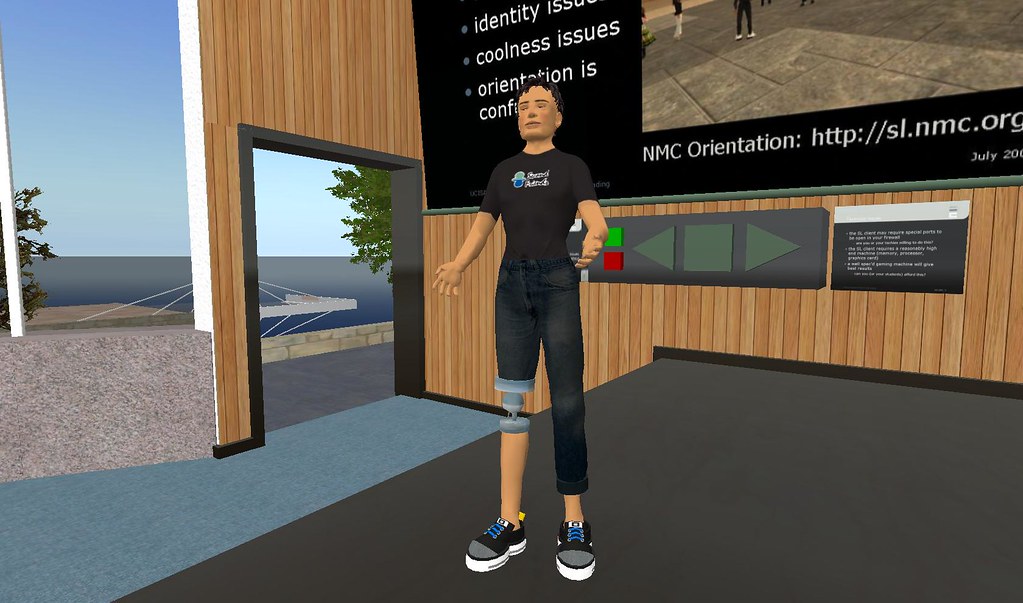
Stephen Downes (rightly)
complains that we spend too much time in Second Life (SL) blandly re-creating what we would do in real life - particularly in the context of teaching and learning, meetings and so on. It's not clear to me whether he was complaining about the SL platform itself, or the people making use of the platform but he was good enough to publish a
series of comments on his original post - essentially pointing out that blaming SL for the tendency of its users to re-create what they do in real life (RL) is like blaming PowerPoint for bad presentations.
I quite like this quote:
Bertrand Russell said that "people like to die by the latest method." He could have been talking about Second Life.
Speaking only for myself, I have as little imagination as the next bloke, probably less. I broadly agree with where Stephen is coming from - I am crap at thinking up different ways of presenting stuff to audiences in-world - but I also think that there are times when simply replicating a RL activity is perfectly OK. I recently spoke about Second Life at the
UCISA User Support Conference (to a real audience of about 100 and a virtual audience of about 15). Roo Reynolds, who was on stage in the RL venue immediately before me suggested that I was about to show them something innovative and new, at which point I proceeded to use SL to show a series of PowerPoint slides on a very traditional-looking screen in something that looked very like a traditional lecture theater. Doh! :-(
In terms of what I was trying to do on the day, which was primarily about introducing the RL audience to SL, I think my chosen pedagogy worked reasonably well. Yes, I could have built a more innovative 'lecture space' - though I have no idea about what such a thing might look like. Yes, I could have used a non-lecture-based pedagogy - though I don't know what I'd have done instead, given the size of the audience and the fact that it was partly in the RL venue and partly in SL.
Suggestions on a postcard please...
Stephen refers to a panel session:
I was part of a panel in Second Life on Monday, and what struck me was how it took place in a virtual lecture hall, and one by one, we all went up to the podium, showed some slides, and lectured to an audience of avatars seated in virtual chairs. We know how to bore you in a classroom, and now we know how to bore you online.
So how could this have been made to work better? Sure, there are trivial things that could have been done... don't make the room look like a lecture hall for a start? Don't provide chairs? Don't provide a podium? Would any of these made the session any better?
Don't allow the use of slides? Seems kind of like throwing the baby out with the bathwater?
Don't give panel members speaking slot at all? Erm...
I think there are interesting possibilities in terms of using your avatar's position in the meeting space and/or colors or other indicators to show how you feel about what is currently being said. That might work well in the context of a panel - where presumably some position (or positions) on a particular topic are being discussed.
On the other hand, discussions in SL tend to be relatively unstructured and chaotic (is that SL's most novel feature?) and my suspicion is that trying to indicate a coherent feeling around a range of disparate threads in a multi-way conversation might be very difficult.
Despite my general skepticism about voice in SL, I do think that it has a place in meeting-like scenarios, i.e. in situations in which there is a speaker who, temporarily at least, is given the floor. Using voice for the speaker is much more efficient and effective than carrying everything by chat. More importantly, it leaves chat open as the back-channel for discussion by the people listening.
I think there are some difficult issues in this area. It's easy to knock SL as a place where unimaginative people simply re-create what happens in the real world. But there are valid reasons why that is done, at least in some cases.
Over to you... how would you use SL to share and discuss 4 positions on a topic without it simply looking like a re-creation of a traditional RL panel session?



